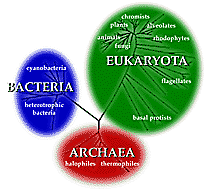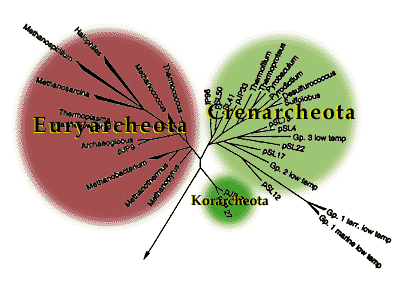







The Archaea constitute one of the three domains into which all known life may be divided. There are two other domains of life. One of these is the Eukaryota, which includes the plants, animals, fungi, and protists. Except for the protists, these organisms have been known and studied since the time of Aristotle, and are the organisms with which you are most likely familiar. The second domain to be discovered was the Bacteria, first observed in the 17th century under the microscope by people such as the Dutch naturalist Antony van Leeuwenhoek.
The tiny size of bacteria made them difficult to study. Early classifications depended on the shape of individuals, the appearance of colonies in laboratory cultures, and other physical characteristics. When biochemistry blossomed as a modern science, chemical characteristics were also used to classify bacterial species, but even this information was not enough to reliably identify and classify the tiny microbes. Reliable and repeatable classification of bacteria was not possible until the late 20th century when molecular biology made it possible to sequence their DNA.
Molecules of DNA are found in the cells of all living things, and store the information cells need to build proteins and other cell components. One of the most important components of cells is the ribosome, a large and complex molecule that converts the DNA message into a chemical product. Most of the chemical composition of a ribosome is RNA, a molecule very similar to DNA, and which has its own sequence of building blocks. With sequencing techniques, a molecular biologist can take apart the building block of RNA one by one and identify each one. The result is the sequence of those building blocks.
 |
 |
A New Domain : In the late 1970s, Dr. Carl Woese (pictured above at left) spearheaded a study of evolutionary relationships among prokaryotes. Instead of physical characters, he relied on RNA sequences to determine how closely related these microbes were. He discovered that the prokaryotes were actually composed of two very different groups -- the Bacteria and a newly recognized group that he called Archaea. Each of these groups is as different from the other as they are from eukaryotes. These three groups are now recognized as three distinct domains of life, as shown above at right.
Because ribosomes are so critically important is the functioning of living things, they are not prone to rapid evolution. A major change in ribosome sequence can render the ribosome unable to fulfill its duties of building new proteins for the cell. Because of this, we say that the sequence in the ribosomes is conserved -- that it does not change much over time. This slow rate of molecular evolution made the ribosome sequence a good choice for unlocking the secrets of bacterial evolution. By comparing the slight differences in ribosome sequence among a wide diversity of bacteria, groups of similar sequences could be found and recognized as a related group.
In the 1970s, Carl Woese and his colleagues at the University of Illinois at Urbana-Champaign began investigating the sequences of bacteria with the goal of developing a better picture of bacterial relationships. Their findings were published in 1977, and included a big surprise. Not all tiny microbes were closely related. In addition to the bacteria and eukaryote groups in the analysis, there was a third group of methane-producing microbes. These methanogens were already known to be chemical oddities in the microbial world, since they were killed by oxygen, produced unusual enzymes, and had cell walls different from all known bacteria.
The significance of Woese's work was that he showed these bizarre microbes were different at the most fundamental level of their biology. Their RNA sequences were no more like those of the bacteria than like fish or flowers. To recognize this enormous difference, he named the group "Archaebacteria" to distinguish them from the "Eubacteria" (true bacteria). As the true level of separation between these organisms became clear, Woese shortened his original name to Archaea to keep anyone from thinking that archaeans were simply a bacterial group.

Archaean Phylogeny : The phylogeny of archaeans is based on molecular sequences in their DNA. The analysis of these sequences reveals three distinct groups within the Archaea. The Euryarcheota are probably the best known, including many methane-producers and salt-loving archaeans. Crenarcheota include those species that live at the highest temperatures of any known living things, though a wide variety have recently been discovered growing in soil and water at more moderate temperatures. The Korarcheota are only known from their DNA sequences -- nothing more is known about them yet since they have only recently been discovered.
Since the discovery that methanogens belong to the Archaea and not to the Bacteria, a number of other archaeal groups have been discovered. These include some truly weird microbes that thrive in extremely salty water, as well as microbes that live at temperatures close to boiling. Even more recently, scientists have begun finding archaea in an increasing array of habitats, such as the ocean surface, deep ocean muds, salt marshes, the guts of animals, and even in oil reserves deep below the surface of the Earth. Archaea have gone from obscurity to being nearly ubiquitous in only 25 years!
Archaeans have increasingly become the study of scientific investigation. In many ways, archaeal cells resemble the cells of bacteria, but in a number of important respects, they are more like the cells of eukaryotes. The question arises whether the Archaea are closer relatives of the bacteria or our our group, the eukaryotes. This is a very difficult question to answer, because we are talking about the deepest branches of the tree of life itself; we do not have any early ancestors of life around today for comparison. One novel approach used in addressing the question is to look at sequences of duplicated genes. Some DNA sequences occur in more than one copy within each cell, presumably because an extra copy was made at some point in the past. There are a very few genes known to exist in duplicate copies in all living cells, suggesting that the duplication happened before the separation of the three domains of life. In comparing the two sets of sequences, scientists have found that the Archaea may actually be more closely related to us (and the other eukaryotes) than to the bacteria.
For more information :


